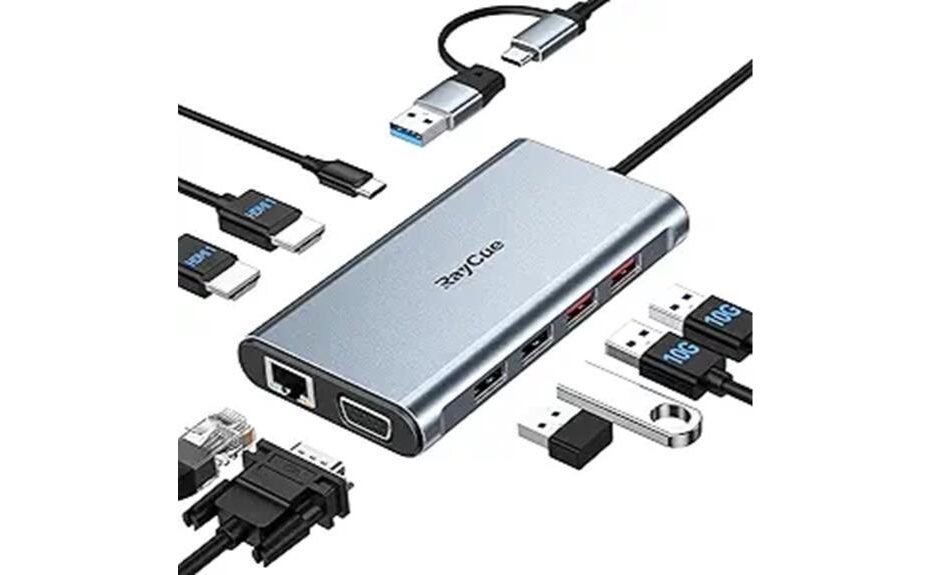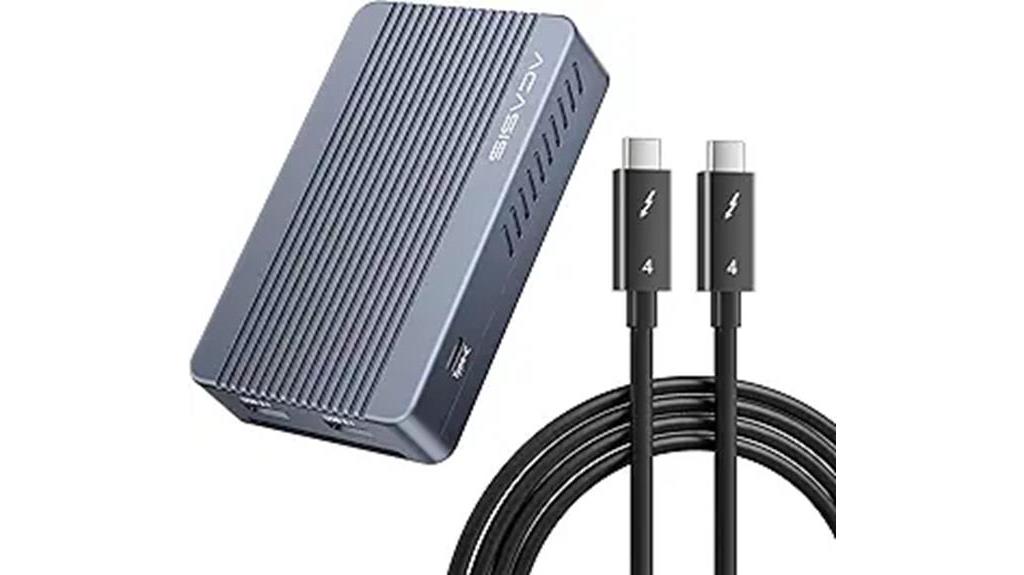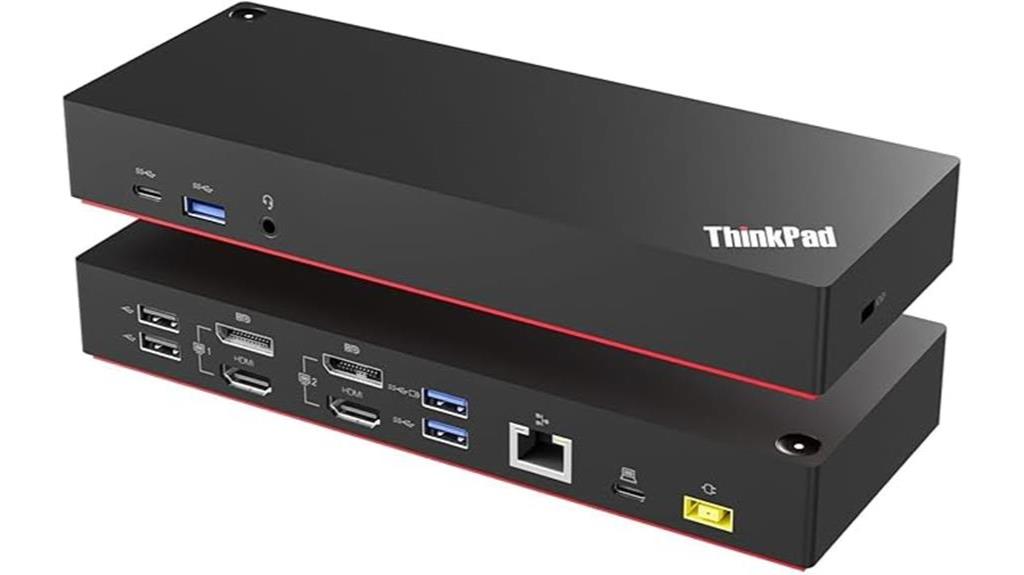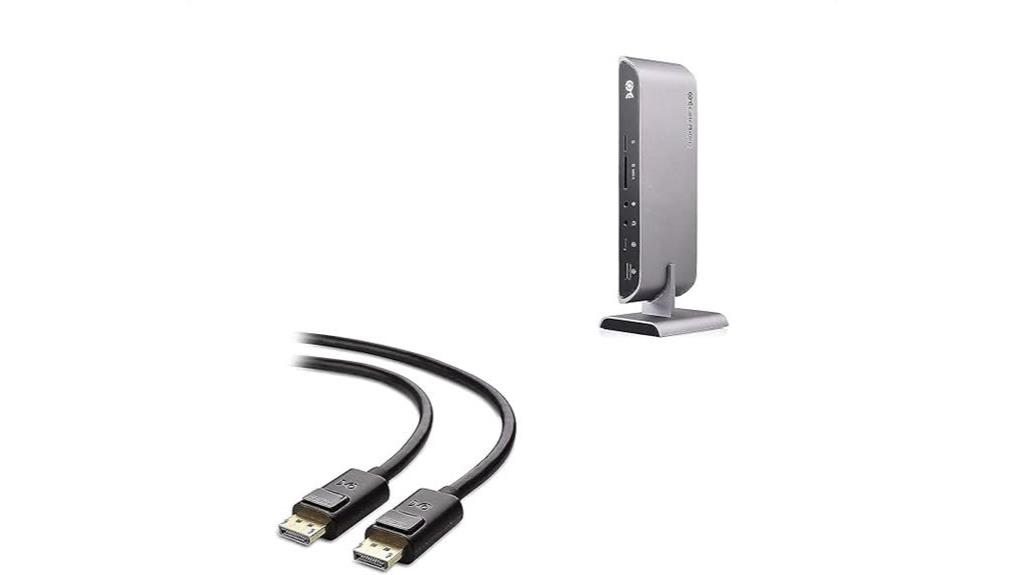
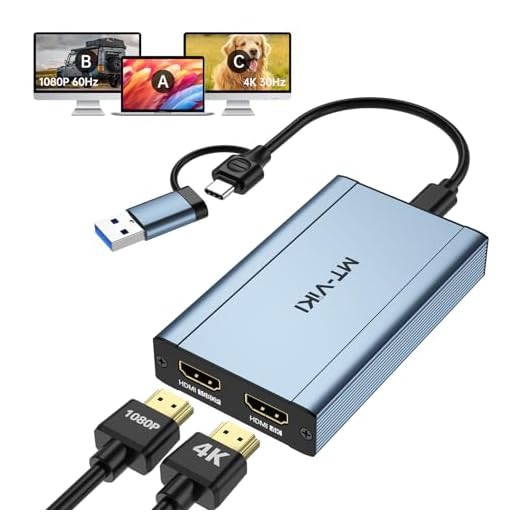


I've explored the RayCue USB Docking Station, and I found it combines sleek design with impressive capabilities. The dual HDMI and VGA ports support multiple monitors while delivering fast data transfer through 10Gbps USB 3.1 connections. However, I encountered challenges during installation, particularly with video drivers. Despite this, the solid construction and intuitive port layout stand out. The USB-C port is limited to power only, which might frustrate some users. Overall, it's a worthy investment for remote workers and gamers seeking productivity boosts. There's much more to uncover about its features and potential drawbacks that could help you decide.
Key Takeaways
- The RayCue USB Docking Station features dual HDMI and VGA support, allowing for multi-monitor setups that enhance productivity and multitasking capabilities.
- It offers 10Gbps USB 3.1 ports for rapid data transfer, significantly improving access to external drives compared to older USB standards.
- Users may face installation challenges, particularly with video driver setup, which can impact initial functionality and user experience.
- The docking station provides a variety of ports, including multiple USB options, catering to diverse connectivity needs and reducing reliance on adapters.
- Overall, it presents a competitive price for its features, making it a valuable investment for remote workers and tech-savvy individuals.
When I first unboxed the RayCue USB Docking Station, I was immediately impressed by its sleek design and array of ports. However, my user experience during installation was a mixed bag. While most ports were plug-and-play, I encountered installation challenges with the video drivers. I had to download the Siliconmotion driver from the included USB stick, which added an extra step I hadn't anticipated. Configuring the monitors was another hurdle, particularly when I tried to extend displays. I found that following the instructions carefully helped, but I can see how less tech-savvy users might struggle. Overall, while the docking station looks great and offers versatility, the installation process requires patience and attentiveness to guarantee everything works smoothly.
Features and Benefits
The RayCue USB Docking Station boasts dual HDMI and VGA support, allowing me to connect multiple external monitors seamlessly. With its 10Gbps USB 3.1 ports, I experience rapid file transfers, optimizing my workflow. However, I've found the manual video driver installation process a bit cumbersome, especially since the USB-C port is designed solely for powering the dock, not for charging my laptop.
Dual HDMI and VGA Support
RayCue's USB Docking Station stands out with its dual HDMI and VGA support, offering users considerable advantages for multitasking and enhancing productivity. With the ability to set up multi display configurations, I can easily extend my laptop's screen to three external monitors, making it ideal for complex projects. The video output compatibility guarantees that I can connect various devices without hassle. I appreciate the flexibility of using both HDMI and VGA, catering to different monitor setups. The HDMI2 port even supports 4K@30Hz, which is perfect for high-resolution displays. This functionality transforms my workspace, allowing me to manage multiple applications simultaneously, streamline workflows, and ultimately, improve my efficiency. Overall, this feature considerably elevates the user experience.
0Gbps USB 3.1 Ports
Offering impressive speed and versatility, the RayCue USB Docking Station's 10Gbps USB 3.1 ports greatly enhance my productivity. In a usb speed comparison, 10Gbps clearly stands out against older USB standards, delivering considerably faster data transfer rates. This means I can transfer large files or backups in a fraction of the time, improving my overall data transfer efficiency. When working on projects that require quick access to multiple external drives, the performance of these ports is invaluable. Plus, the backward compatibility with USB 3.0 and 2.0 devices guarantees I can connect all my peripherals without issues. Overall, these USB 3.1 ports are a game changer, making my workflow smoother and more efficient.
USB-C Power-Only Port
One notable feature of the RayCue USB Docking Station is its USB-C power-only port, which serves a specific purpose in enhancing user experience. This port primarily delivers power to the docking station itself, guaranteeing that it operates efficiently. However, it is vital to understand the USB-C limitations here; you can't use this port to charge your laptop or other devices. While power delivery is important for maintaining stable performance, the lack of charging capability can be a drawback for some users. This means that I need to rely on separate power sources for my devices, which may not be ideal in every setup. Overall, while the power-only feature guarantees the docking station functions well, it does limit versatility in device charging.
Manual Video Driver Installation
Manual installation of video drivers for the RayCue USB Docking Station is an important step that directly impacts the overall performance and functionality of the device. I've encountered installation challenges that made it clear this process isn't as straightforward as plug-and-play. Properly installing the Siliconmotion driver is vital for achieving ideal display capabilities, especially when extending screens across multiple monitors. I've faced driver troubleshooting issues, which can be frustrating, but following the installation instructions carefully can mitigate many problems. Once installed correctly, the performance greatly improves, enhancing my multitasking capabilities with clearer visuals and smoother changes. Overall, taking the time to manually install the video drivers has proven beneficial, ensuring I maximize the docking station's potential.
Product Quality
Examining the RayCue USB Docking Station reveals a solid construction that balances functionality with portability. The build quality stands out; it feels durable without being excessively bulky, making it easy to transport. I appreciate the design aesthetics, which are sleek and modern, complementing my workspace nicely. The arrangement of ports is intuitive, allowing for easy access while maintaining a tidy appearance. However, while the overall design is appealing, I noticed some users expressing concerns about the longevity of specific components, especially the USB ports. Despite these minor critiques, the docking station's robust feel and thoughtful design contribute positively to its overall quality, making it a reliable choice for both home and professional use.
What It's Used For
I find the RayCue USB Docking Station particularly useful for creating a multi-monitor setup, which greatly enhances my productivity. With its variety of ports, I can connect multiple peripherals and displays, streamlining my workflow. This docking station not only supports extended screens but also facilitates efficient file transfers, making it a versatile tool for anyone looking to boost their computing experience.
Multi-Monitor Setup Benefits
Efficiency is an essential element in today's fast-paced work environment, and a multi-monitor setup greatly enhances productivity. With multiple screens, I can manage various tasks simultaneously, which reduces the need to switch between applications constantly. Different monitor configurations allow me to dedicate each screen to specific functions—one for emails, another for research, and the third for spreadsheets. This organization streamlines my workflow and minimizes distractions, leading to significant productivity enhancement. Additionally, having additional display space enables me to visualize data more effectively, making it easier to draw insights. Overall, investing in a multi-monitor setup has transformed how I work, allowing me to tackle projects more efficiently and with greater focus.
Enhanced Productivity Features
A diverse array of enhanced productivity features makes the RayCue USB Docking Station an invaluable tool for modern professionals. With the capability to connect up to three monitors, I can easily implement multitasking strategies that maximize efficiency. For instance, I often use one screen for research, another for document editing, and the third for communication apps. This setup aligns perfectly with my productivity tips, as it allows me to streamline tasks without constantly switching windows. The high-speed USB 3.1 ports facilitate rapid file transfers, reducing downtime during projects. Additionally, I appreciate the lightweight design, making it easy to transport between home and the office. Overall, the docking station greatly boosts my productivity and enhances my workflow.
Port Variety and Usefulness
The RayCue USB Docking Station's diverse port variety greatly enhances its usefulness for various tasks, making it a versatile addition to any workspace. With two HDMI ports and one VGA port, I can easily connect multiple monitors, which is perfect for multitasking. The two USB 3.1 ports offer rapid file transfers, while the USB 2.0 ports are ideal for peripherals like keyboards and mice. I've found that good port organization helps maintain efficient cable management, reducing clutter on my desk. This setup not only streamlines my work but also keeps my workspace tidy. Overall, the docking station is instrumental in maximizing my productivity and ensuring that I have the right connections at my fingertips.
Product Specifications
When considering the RayCue USB Docking Station, it's essential to explore its product specifications to understand its capabilities. This docking station offers impressive monitor compatibility, supporting dual HDMI and VGA outputs, making it suitable for extending or mirroring laptop screens across three external displays.
Here's a breakdown of its key specifications:
| Feature | Details |
|---|---|
| Ports | 2 HDMI, 1 VGA, 2 USB 3.1, 2 USB 2.0, 1 USB charging |
| Maximum Resolution | HDMI2 at 4K@30Hz |
| Compatibility | Mac OS X 10.6+, Windows 7+ |
With these specifications, the RayCue docking station not only enhances productivity but also caters to diverse user needs, making it a valuable addition to any workspace.
Who Needs This
For professionals juggling multiple tasks, the RayCue USB Docking Station proves indispensable. It's perfect for those engaged in remote work, allowing seamless connectivity to various peripherals and multiple monitors. I've found that its dual HDMI and VGA ports are especially useful for setting up a productive workspace at home, where I can easily manage different projects simultaneously.
Gamers, too, will appreciate the docking station's ability to enhance their gaming setup. The 4K@30Hz support through HDMI allows for crisp visuals, elevating the gaming experience. With its diverse port options, this docking station caters to anyone who needs to expand their workspace or gaming rig efficiently. Overall, it's a valuable tool for enhancing productivity and leisure.
Pros
One standout feature of the RayCue USB Docking Station is its extensive range of ports, which greatly enhances connectivity options for users. This variety not only improves user experience but also minimizes the need for additional adapters. Here are some key advantages I've noticed:
- Versatile Display Options: Dual HDMI and VGA support for multiple monitors.
- Rapid Data Transfer: 10Gbps USB 3.1 ports guarantee fast file transfers.
- Multiple USB Ports: Ample connections for peripherals, enhancing productivity.
- Broad Compatibility: Works well with various devices, from MacBooks to Dell laptops.
While some users reported installation challenges, particularly with driver setups, the overall functionality and design make it a valuable tool for any tech setup.
Cons
Despite its many advantages, the RayCue USB Docking Station does come with a few notable drawbacks that potential users should consider. Here are the key cons I've noticed:
- Driver Issues: Initial setup requires downloading specific drivers, leading to frustration for some users.
- Monitor Limitations: Many users report difficulties with extending displays, which can hinder productivity.
- Lack of Headset Jack: The absence of an audio port limits audio connectivity options, which is disappointing for multimedia users.
- USB-C Power-Only: The USB-C port is solely for power, not for connecting devices, making it less versatile.
These limitations could impact your experience, especially if you rely heavily on multiple monitors or seamless audio integration.
What Customers Are Saying
Customer feedback on the RayCue USB Docking Station reveals a mix of satisfaction and frustration, showcasing the product's strengths and weaknesses. Many users express high user satisfaction with the variety of ports, which enhance connectivity options. Customer experiences highlight impressive file transfer speeds, considerably boosting productivity. However, installation issues arise, particularly with video drivers, leaving some users feeling frustrated. The lack of a headset jack and reported audio issues when connecting to monitors also dampens the overall experience. While some customers appreciate its lightweight design and portability, others are disappointed with limitations in monitor mirroring and the USB-C port being power-only. Overall, the feedback paints a nuanced picture, illustrating both the potential and pitfalls of the docking station.
Overall Value
The RayCue USB Docking Station presents a compelling value proposition for users seeking enhanced connectivity and performance. When considering price comparison, it stands competitively against similar products, offering a robust feature set that includes dual HDMI and USB 3.1 ports essential for professionals who rely on multiple displays. User demographics reveal that tech-savvy individuals and remote workers particularly benefit from its capabilities, as they often need efficient multitasking solutions. Despite some installation hurdles, the overall functionality and versatility justify the investment. The docking station appeals to users looking for quality without breaking the bank, making it a solid choice for enhancing productivity in various work environments.
Tips and Tricks For Best Results
To get the most out of your RayCue USB Docking Station, I recommend following a few key tips that can enhance your experience. First, make sure you install the latest drivers from the included USB stick; this step is essential for peak performance and can prevent many issues. It's also a best practice to connect monitors before powering on your laptop to avoid configuration headaches. If you encounter display problems, try adjusting the resolution settings or using different HDMI ports, as some users found this helpful. Keep your docking station firmware updated for the best compatibility. Finally, if you experience audio issues, check your audio settings; often, a simple tweak can resolve these troubleshooting tips effectively.
Conclusion
Ultimately, RayCue's USB Docking Station offers a solid balance of versatility and performance, making it a worthwhile investment for users needing multiple connections. The user experience is enhanced by its impressive range of ports and fast data transfer speeds, but installation challenges may deter some. While most ports are plug-and-play, the necessity to download specific drivers can be frustrating, particularly for those unfamiliar with the process. Additionally, issues with monitor configurations, especially when extending displays, have been reported. Despite these hurdles, the docking station's capability to connect various devices and support multiple monitors is commendable. Overall, if you can navigate the initial setup, this docking station greatly boosts productivity and connectivity.
Frequently Asked Questions
Does the Docking Station Support Audio Output Through Hdmi?
I've found that the docking station does support audio output through HDMI, adhering to standard HDMI specifications. However, some users report mixed audio quality results, particularly when connecting multiple displays or using specific configurations.
Can It Charge Devices While in Use?
I've found that while the docking station powers on, it doesn't charge devices during use. Its charging speed is limited to powering the dock itself, affecting overall device compatibility for charging while connected.
Is There a Warranty Available for the Docking Station?
I've checked, and yes, there's warranty coverage available for the docking station. Customer support is responsive, so I recommend reaching out for any issues. It's reassuring to know help is there if needed.
What Is the Weight of the Raycue USB Docking Station?
I weighed the RayCue USB Docking Station, and it's approximately 0.8 pounds. Its lightweight design features various connectivity options, enhancing portability while maintaining an efficient setup for multiple monitors, making it quite practical for my needs.
Are There Any Known Compatibility Issues With Specific Laptop Models?
I've noticed mixed user experiences with specific laptop brands. Some users report compatibility issues, particularly with monitor configurations on certain models, which can lead to frustration during setup and operation, impacting overall satisfaction with the docking station.
Disclosure: As an Amazon Associate, I earn from qualifying purchases.
